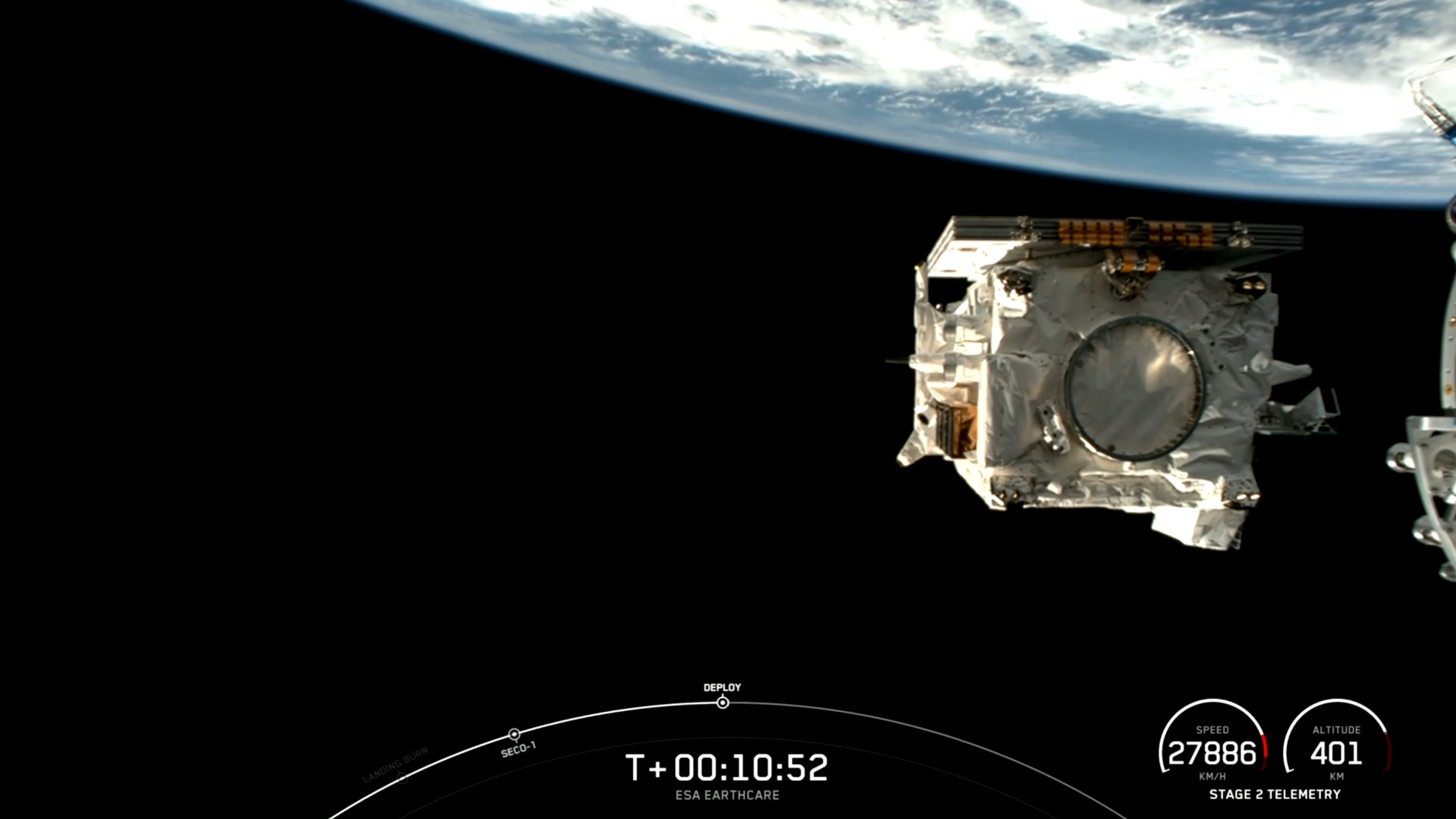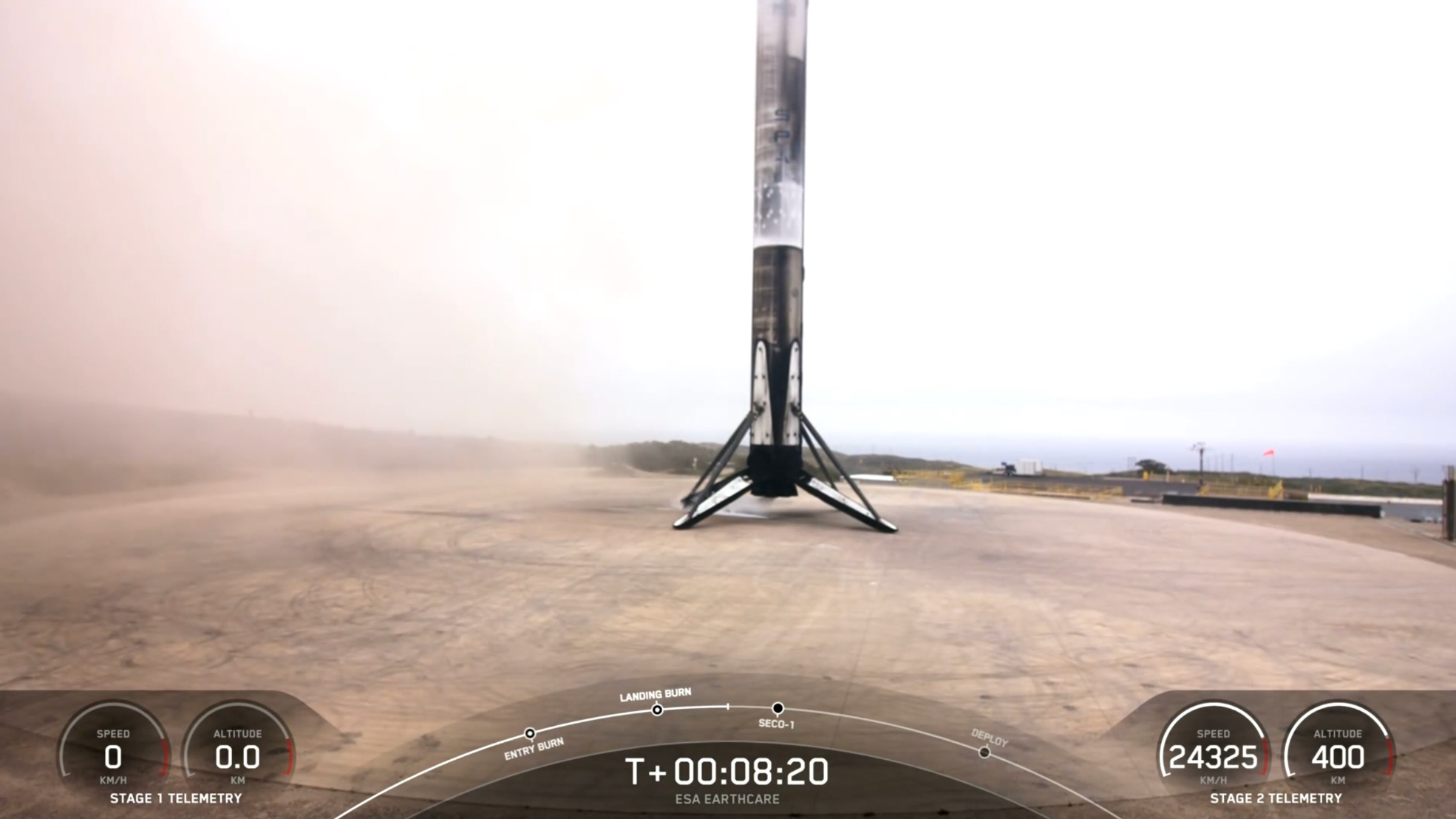SpaceX launches Earth-observing EarthCARE satellite during rocket flight doubleheader (photos, video)
Launch of the EarthCARE mission occurred at 6:20 p.m. ET.
A new Earth-observation mission made it to space today (May 28).
A Falcon 9 rocket from SpaceX lifted off with the Earth Cloud Aerosol and Radiation Explorer satellite, or EarthCARE for short, from Vandenberg Space Force Base in California today at 6:20 p.m. EDT (2220 GMT or 3:20 p.m. local time in California).
It was the second launch of the day for SpaceX, which also sent a group of its Starlink internet satellites to orbit from Cape Canaveral Space Force Station in Florida this morning.
The Falcon 9 first-stage booster flying this mission has now made it to space seven times, according to a SpaceX mission description. Among its previous missions were the Crew-7 Crew Dragon astronaut launch to the International Space Station, the CRS-29 cargo flight to the ISS and two Starlink missions.
The booster landed successfully back at Vandenberg today, roughly eight minutes after launch. About 2.5 minutes later, the Falcon 9's upper stage deployed EarthCARE into orbit as planned.
Related: The 1st photo of Earth from Europe's powerful new satellite is amazing

EarthCARE is a cooperative mission between the European Space Agency (ESA) and the Japan Aerospace Exploration Agency (JAXA). The mission will "examine the role that clouds and aerosols play in reflecting solar radiation back into space and also in trapping infrared radiation emitted from Earth's surface," according to ESA.
Get the Space.com Newsletter
Breaking space news, the latest updates on rocket launches, skywatching events and more!
Learning about the solar radiation balance on our planet "is crucial for addressing climate-related issues, and is something that can only be done from space," ESA added.
The mission will operate at an orbit similar in altitude to that of the ISS (250 miles, or 400 kilometers), but on a different plane: Instead of the more equatorial-focused ISS, EarthCARE will fly a sun-synchronous polar orbit that crosses the equator at local early afternoon, when sunlight is strongest in the region.

The mission will gaze down at particles of clouds and molecules of aerosols, or suspended particles in the atmosphere, to see how they interact with precipitation and how quickly they fall to our planet. EarthCARE will also "register the distribution of water droplets and ice crystals and how they are transported in clouds."
"This essential data will improve the accuracy of both cloud development models and their behavior, composition and interaction with aerosols, as well as improve future climate models and support numerical weather prediction," ESA officials added.
The satellite carries four scientific instruments: atmospheric lidar (a pulsed laser) to scrutinize the cloud tops and cloud and aerosol profiles; a cloud-profiling radar to learn about cloud motion, dynamics and structure; a broadband radiometer to examine solar radiation and infrared radiation; and a multispectral imager.
EarthCARE is expected to undergo a six-month commissioning period after launch, and its primary mission is scheduled to last at least three years. It was previously expected to launch on top of a Russian rocket, but mission officials switched to SpaceX after Russia's invasion of Ukraine in 2022, which severed most space partnerships with that nation.
Editor's note: This story was updated at 6:35 p.m. EDT on May 28 with news of successful launch, rocket landing and satellite deployment.
Join our Space Forums to keep talking space on the latest missions, night sky and more! And if you have a news tip, correction or comment, let us know at: community@space.com.

Elizabeth Howell (she/her), Ph.D., was a staff writer in the spaceflight channel between 2022 and 2024 specializing in Canadian space news. She was contributing writer for Space.com for 10 years from 2012 to 2024. Elizabeth's reporting includes multiple exclusives with the White House, leading world coverage about a lost-and-found space tomato on the International Space Station, witnessing five human spaceflight launches on two continents, flying parabolic, working inside a spacesuit, and participating in a simulated Mars mission. Her latest book, "Why Am I Taller?" (ECW Press, 2022) is co-written with astronaut Dave Williams.









